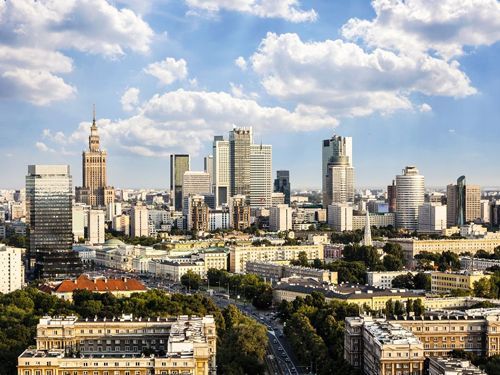Why invest in Poland?
Construction
The eight main factors the report examines include infrastructure, the labour market, education, the standard of living and the how business friendly the local authorities are. Those surveyed were asked to rate the quality of the business environment in their cities on a scale of 1 to 10. The report also includes market data on living costs, office rents and salaries, which was collated by Antal, Cushman & Wakefield, Vastint, ABSL, the Central Statistical Office of Poland (GUS) and the National Bank of Poland.
Real estate
The two major strengths of Polish real estate are its unconventional office space and its attractive pricing. In anaylising how attractive Polish real estate is the following factors were examined: transportation, the quality of the space, its availability, the additional amenities in a building or its immediate vicinity and the office space attractiveness. The cities that were ranked highest for their real estate (with scores out of ten) are: Lublin (8), the TriCity (4) and Kraków (2). “Lublin has once again proven its status as one of the most investor-friendly cities in Poland. Lublin is a great choice for companies looking to lower their operating costs as it is approximately 20–30 pct cheaper to do business there than in central or western Poland. But potential investors usually expect more than just being able to operate on the cheap. The business environment, the office space quality and the availability of amenities that improve the quality of life are all considered important – and I am happy to say that Lublin delivers in all of these areas,” says Agnieszka Gułaś, a negotiator at Cushman & Wakefield. Monthly office rents in Poland’s regional cities range from EUR 13.3 per sqm in Szczecin, to EUR 14.75 per sqm in Wrocław. In Warsaw, however, rents even go up to as much as EUR 23.75 per sqm.
Infrastructure
Poland is rapidly developing its infrastructure, including its roads, railways, airports and seaports. Some cities stand out, such as the TriCity with its direct access to Poland’s biggest seaport, which is a major advantage that sets it apart from the country’s other big cities. Others, like Warsaw, are well-connected within the country’s infrastructure. Despite not being one of Poland’s top three cities, Łódź scored the highest for its international road connections (8.6 out of 10) and rail connections (7.9 out of 10). The cities which have the best infrastructure are the TriCity (with 7.4 points), Kraków (7.2) and Poznań (7.1).
Business activity
Data collated by the National Bank of Poland confirm that Poland is doing well as a place to do business with a 20 pct rise in FDI in 2018. Poland’s competitive advantages include its highly skilled labour and large number of suppliers. The report includes an assessment of the level of competition on a scale of from 0 to 10. The leaders of in the business activity category were Wrocław (7.8), Warsaw (7.6) and Kraków (7.3).
Human capital
A region’s labour market is determined by a number of factors. Potential investors look at the level of education in a region and the number of students studying each particular subject. Wrocław is home to large numbers of engineering students (17,600), while Poznań specialises in linguistics with over 25,200 students and Warsaw has the most studying computer science (over 16,000). For the educational quality of the available labour, Kraków scored 8.6 out of 10, the TriCity and Lublin 7.9, while Warsaw and Wrocław scored 7.8.
Availability of qualified labour
Lublin has the largest pool of qualified workers out of all Poland’s regional cities. One in five of the city’s residents have changed jobs only once throughout their careers, and one in three have only worked for the same company. Unlike Warsaw, where the demand for skilled labour exceeds the supply, Lublin has many qualified workers who are ready to start new jobs. Lublin scored highest with 7.4 out of 10, Warsaw came second with 7.2 and Kraków third with 7.0. “Having access to the best talent in the country, Warsaw, Kraków and Wrocław are also home to almost 50 pct of Poland’s shared services and outsourcing centres. Most workers employed in the industry live in those three cities,” says Karolina Korzeniewska, an account executive at Antal for the CEE region.
Quality of life
Human capital is a crucial factor when choosing where to invest, and as a result factors such as the cost of living, comfort and location are taking on increasing importance. Today the recreational and shopping facilities in a city also contribute to its business environment. The TriCity is ranked as the city with the best quality of life and even scores higher than such cities as Lisbon, Paris and Rome in international rankings. The study was conducted in 2017–2019 and was based on a sample of 588 decision-makers, including CEOs, board members and company directors in Poland.





















































